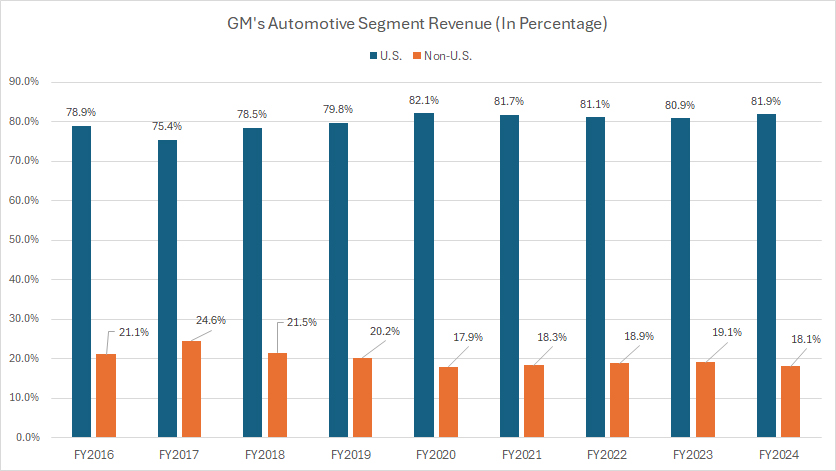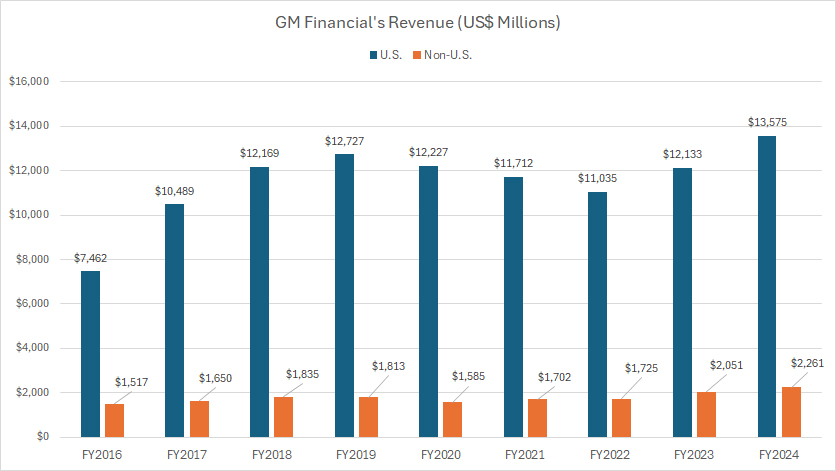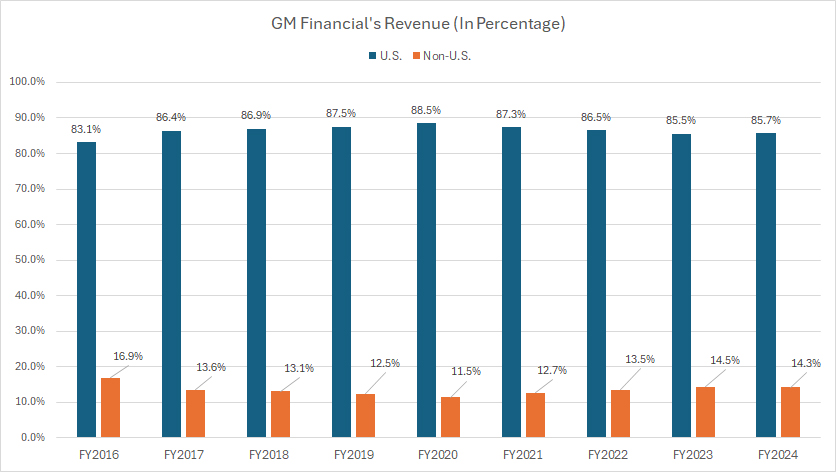
Finance. Pexels Image.
This article provides an in-depth analysis of GM’s revenue distribution by region and country, with a particular focus on key markets such as the U.S. and internationally.
General Motors (GM) operates through two principal divisions: Automotive and GM Financial. The definitions of these divisions are available here: Automotive and GM Financial.
You may find key statistic of General Motors on these pages:
- GM global sales and market share,
- GM sales by country – U.S., China, Brazil, U.K., etc., and
- GM revenue breakdown by category.
Let’s take a look!
Please use the table of contents to navigate this page.
Table Of Contents
Definitions And Overview
O2. What contribute to the significant growth of GM’s revenue from the U.S.?
Automotive Segment
A1. Automotive Revenue: U.S. And International Markets
A2. Percentage Of Automotive Revenue: U.S. And International Markets
GM Financial
B1. GM Financial Revenue: U.S. And International Markets
B2. Percentage Of GM Financial Revenue: U.S. And International Markets
Summary And Reference
S1. Conclusion
S2. References and Credits
S3. Disclosure
Definitions
To help readers understand the content better, the following terms and glossaries have been provided.
Revenue By Region: GM defines its automotive revenue as sales attributed to geographic areas based on the country of sale.
On the other hand, GM Financial revenue is attributed to the geographic area where the financing is originated.
Automotive: General Motors’ (GM) automotive segment encompasses a wide range of activities related to the design, production, and sale of vehicles. This segment is divided into several key regions, each addressing specific market demands and consumer preferences.
-
GM North America (GMNA)
- GM North America is a major revenue generator for the company. It focuses on the design, production, and sale of vehicles in the United States and Canada. The vehicle brands under this segment include Chevrolet, GMC, Buick, and Cadillac.
- GMNA is known for its robust lineup of cars, trucks, and SUVs, catering to a diverse range of customers. The region’s strong market presence and brand loyalty contribute significantly to GM’s overall financial performance.
-
GM International (GMI)
- GM International operates in regions such as Latin America, Africa, the Middle East, and Asia-Pacific. This segment focuses on designing, producing, and selling vehicles tailored to the unique preferences and regulatory requirements of these diverse markets.
- By leveraging GM’s global scale and expertise, GMI aims to meet the needs of consumers in various countries and expand GM’s footprint internationally.
GM Financial: General Motors Financial Company, Inc., commonly known as GM Financial, is the wholly owned captive finance subsidiary of General Motors (GM). It was founded in 1992, originally as AmeriCredit Corporation, and was acquired by GM in October 2010. The company’s headquarters are located in Fort Worth, Texas, USA.
GM Financial provides a wide range of financial services to support GM’s automotive operations. These services include retail loan and lease programs, offering attractive financing and leasing options for customers purchasing GM vehicles.
In addition to consumer financing, GM Financial also offers commercial lending products, such as retail floorplan financing, construction loans, real estate loans, and insurance for car dealerships. This comprehensive suite of financial services is designed to facilitate the purchase and leasing process for both individual customers and dealerships.
Operating on a global scale, GM Financial has a presence in North America, Latin America, Europe, and Asia. Notably, the company operates a joint venture in China, further extending its reach in the international market.
Although GM’s core European operations, Opel and Vauxhall, were sold to PSA Groupe and BNP Paribas in 2017, GM Financial continues to provide financial services in the region.
GM Financial plays a crucial role in supporting GM’s automotive sales by providing flexible financing solutions. This support helps GM maintain a competitive edge in the market by making it easier for customers to purchase or lease GM vehicles.
GM Financial’s success is largely dependent on building strong, lasting relationships with auto dealers and customers, ensuring best-in-class customer service and promoting open, honest communication at all levels.
What contribute to the significant growth of GM’s revenue from the U.S.?
Several factors have contributed to GM’s significant revenue growth in the U.S.:
- Strong Product Lineup
- GM’s diverse and appealing product lineup, including popular models like the Chevrolet Silverado, GMC Sierra, and Cadillac Escalade, has driven strong sales. The introduction of new or refreshed models, such as the Chevrolet Equinox EV and Cadillac LYRIQ, has also attracted a wide range of customers.
- Expansion in Electric Vehicles (EVs)
- GM’s commitment to electric vehicles has been a major growth driver. The company has invested heavily in EV development and production, leading to a substantial increase in EV sales. The launch of models like the Chevy Equinox EV and Cadillac LYRIQ has bolstered GM’s position in the EV market.
- Market Share Gains
- GM has successfully expanded its market share in the U.S., reaching 16.5% in 2024. This growth is attributed to strong sales across all its brands, including Chevrolet, GMC, Buick, and Cadillac.
- Operational Efficiency
- GM’s efficient production processes and cost management have contributed to its profitability and revenue growth. The company has streamlined its operations to reduce costs and improve margins.
- Consumer Demand
- GM’s ability to meet consumer demand with a diverse range of vehicles, from full-sized pickups to electric SUVs, has driven sales growth. The company’s focus on design, performance, and innovation has resonated with customers.
- Strategic Investments
- GM’s investments in new technologies, manufacturing facilities, and research and development have positioned it for long-term growth. The company’s focus on innovation and sustainability has attracted a loyal customer base.
- Economic Conditions
- Favorable economic conditions, including low interest rates and increased consumer spending, have also contributed to GM’s revenue growth. The overall health of the U.S. economy has supported higher vehicle sales.
These factors collectively highlight GM’s strategic approach to growth and its ability to adapt to changing market dynamics.
Automotive Revenue: U.S. And International Markets
GM-automotive-revenue-U.S.-and-international
(click image to expand)
The definition of GM’s automotive segment is available here: automotive. How GM defines its revenue according to country and region: revenue by region.
GM generates significantly higher revenue from the U.S. market compared to the international market within the automotive segment, as illustrated in the graph above.
In fiscal year 2024, GM’s U.S. automotive revenue reached an impressive $140.5 billion, setting a record over the past nine years and marking a 10% increase from the $127.5 billion reported in fiscal year 2023. This substantial growth highlights GM’s strong performance in its domestic market.
A notable trend is the significant revenue growth within the U.S. market since fiscal year 2020. GM’s automotive revenue in the U.S. bottomed out at $89.2 billion in fiscal year 2020. Since then, it has risen by more than 50%, increasing from $89.2 billion to $140.5 billion over the past five years. This remarkable recovery and growth trajectory demonstrate GM’s resilience and strategic success in the U.S.
Looking at a longer-term perspective, from fiscal year 2016 to 2024, GM’s automotive revenue in the U.S. has increased by 27%, rising from $110.7 billion to $140.5 billion over the presented timeframe. This steady growth underscores the company’s ability to adapt and thrive in its primary market.
In contrast, GM’s international automotive revenue amounted to only $31.1 billion in fiscal year 2024, representing about 22% of its U.S. automotive revenue in the same period. While the international market contributes to GM’s overall revenue, it remains significantly smaller than the U.S. market.
Compared to the significant growth observed in the U.S., GM’s non-U.S. automotive revenue has remained relatively flat between fiscal years 2016 and 2024, increasing by a modest 5%. However, there has been a notable jump from fiscal year 2020 to 2024. During this period, GM’s non-U.S. revenue increased by 59%, rising from a low of $19.5 billion to $31.1 billion over five years. This recent growth indicates a positive trend and potential for further expansion in international markets.
Overall, GM’s dominant revenue generation from the U.S. market highlights the company’s strong foothold and competitive advantage in its domestic market, while the international segment shows promising signs of growth and diversification.
Percentage Of Automotive Revenue: U.S. And International Markets
GM-automotive-revenue-U.S.-and-international-in-percentage
(click image to expand)
The definition of GM’s automotive segment is available here: automotive. How GM defines its revenue according to country and region: revenue by region.
The percentage of GM’s U.S. automotive revenue relative to the total has risen from 79% in fiscal year 2016 to 82% as of fiscal year 2024. This increase highlights the growing dominance of the automaker’s U.S. market on its overall financial performance. The U.S. market continues to be a critical driver of GM’s revenue growth, reflecting strong consumer demand and a solid product lineup.
In contrast, the percentage of GM’s automotive revenue from the international market has declined from 21% in fiscal year 2016 to 18% in fiscal year 2024. This shift illustrates the diminishing significance of the non-U.S. market in GM’s revenue distribution.
Despite the reduction in its revenue share, the international market remains an important contributor to GM’s overall revenue. In fiscal year 2024, the international market accounted for a substantial 18% of GM’s total automotive revenue, underscoring its ongoing relevance.
It’s important to note that while the international market’s revenue share has decreased, there are opportunities for growth and expansion. GM’s recent efforts to introduce new models and technologies in international markets, along with strategic investments, could potentially enhance its global revenue performance in the coming years.
Essentially, GM’s increasing reliance on the U.S. market for automotive revenue reflects its strong market presence and competitive advantage domestically, while the international market continues to play a vital, albeit smaller, role in the company’s financial landscape.
GM Financial Revenue: U.S. And International Markets
GM-Financial-revenue-U.S.-and-international
(click image to expand)
The definition of GM Financial is available here: GM Financial. How GM defines its revenue according to country and region: revenue by region.
Similar to the automotive segment, GM Financial also generates the majority of its revenue from the U.S., as depicted in the graph above.
In fiscal year 2024, GM Financial’s revenue from the U.S. totaled $13.6 billion, while its non-U.S. revenue amounted to only $2.3 billion in the same period. This represents just 17% of the U.S. revenue, highlighting the significant difference in revenue generation between the domestic and international markets for GM Financial.
From fiscal year 2020 to 2024, GM Financial’s revenue from the U.S. rose by 11%, reflecting steady growth in the domestic market. When viewed over a longer-term perspective, from fiscal year 2016 to 2024, GM Financial’s U.S. revenue grew by over 80%, showcasing a substantial and sustained increase in financial performance within the United States.
Comparatively, GM Financial’s U.S. revenue of $13.6 billion in fiscal year 2024 marked an impressive 12% jump from the $12.1 billion reported in fiscal year 2023. This growth underscores the company’s strong foothold and increasing influence in the domestic market.
While GM Financial earns significantly lower revenue from the international market, it has shown considerable growth over the years. In fiscal year 2024, GM Financial’s non-U.S. revenue reached an impressive $2.3 billion, reflecting a 10% increase over 2023. This growth indicates GM Financial’s expanding presence and potential in international markets.
On a longer-term perspective, from fiscal year 2020 to 2024, GM Financial’s non-U.S. revenue grew by more than 40%, increasing from $1.6 billion to $2.3 billion over the five-year period. This remarkable growth demonstrates the company’s successful efforts to penetrate and expand its reach in global markets.
Looking at an even longer-term period, from fiscal year 2016 to 2024, GM Financial’s non-U.S. revenue has grown by more than 50%. During this time frame, international revenue rose from $1.5 billion to $2.3 billion, marking a significant increase and highlighting the company’s successful global strategy.
Essentially, while GM Financial’s revenue from the international market remains lower than its U.S. revenue, the impressive growth rates over the years indicate a promising trend. The company’s strategic initiatives and investments in global markets are contributing to its increasing revenue and market presence worldwide.
Percentage Of GM Financial Revenue: U.S. And International Markets
GM-Financial-revenue-U.S.-and-international-in-percentage
(click image to expand)
The definition of GM Financial is available here: GM Financial. How GM defines its revenue according to country and region: revenue by region.
The percentage of GM Financial’s revenue generated from the U.S. market has seen a modest increase from fiscal year 2016 to 2024. During this period, the U.S. revenue share rose from 83% to 86%, peaking at 88.5% in fiscal year 2020. This rise highlights the growing dominance of GM Financial’s domestic market on its overall financial performance.
Conversely, GM Financial’s revenue from the international market accounted for only 14% of the total revenue in fiscal year 2024, down slightly from 17% in fiscal year 2016. This decline underscores the reduced significance of the international market in GM Financial’s revenue distribution over the years.
Notably, the international revenue share hit a low of 11.5% in fiscal year 2020, before recovering to 14% in fiscal year 2024. This recovery indicates potential growth opportunities and renewed focus on expanding GM Financial’s presence in global markets.
While the international market’s revenue share has declined overall, it remains a substantial contributor to GM Financial’s total revenue. The recovery in recent years suggests that strategic initiatives and investments are yielding positive results, enhancing the company’s global revenue performance.
In summary, GM Financial’s increasing reliance on the U.S. market for revenue generation highlights its strong market position domestically, while the international market, despite a reduced share, continues to play a vital role in the company’s financial landscape.
Conclusion
In summary, GM’s significant revenue generation from the U.S. market in both the automotive and financial segments highlights its strong market presence and operational efficiency domestically. The consistent growth in U.S. revenue underscores GM’s ability to meet consumer demand and maintain a competitive edge with a robust product lineup and effective financial services.
While the international revenue share for both segments has declined, the notable growth rates in recent years indicate substantial opportunities for expansion. By continuing to invest in and develop international markets, GM can diversify its revenue sources and reduce its reliance on the U.S. market. This strategic focus on global expansion could enhance the company’s resilience and drive sustained growth in the long term.
Overall, GM’s strong performance in the U.S. market combined with its growth potential in international markets presents a promising outlook for both its automotive segment and GM Financial.
References and Credits
1. All data presented were obtained and referenced from GM’s annual reports published on the company’s investor relations page: General Motors Investor Relation.
2. Pexels Images.
Disclosure
We may use the assistance of artificial intelligence (AI) tools to produce some of the text in this article. However, the data is directly obtained from original sources and meticulously cross-checked by our editors multiple times to ensure its accuracy and reliability.
If you find the information in this article helpful, please consider sharing it on social media. Additionally, providing a link back to this article from any website can help us create more content like this in the future.
Thank you for your support and engagement! Your involvement helps us continue to provide high-quality, reliable content.




